by Ilaria Baratta , published on 10/12/2020
Categories: Works and artists
/ Disclaimer
The Baptistery of Parma, built between 1196 and 1216, has two masterpieces by Benedetto Antelami on its facade: the zooforo and sculpted portals.
In the historic center of Parma stands near the cathedral one of the greatest artistic feats of Italy’s 13th century, the Baptistery, whose exterior denotes a close link between sculpture and architecture, as only Benedetto Antelami (Val d’Intelvi, c. 1150 - Parma, 1230) knew how to do. Considered among the most significant monuments of the transition from Romanesque to Gothic, it refers to the most modern European cultural trends of the time, because unlike the Romanesque tradition and more similarly instead to the portals of French Gothic churches, such as Chartres, Notre-Dame and Amiens, a strong iconographic connection between lunette, architrave and archivolt is delineated, to which sculpted jambs, typical of the Romanesque tradition, are added. Romanesque elements are mixed in the Parma Baptistery with typically Gothic elements, such as the vertical development of the structure, similar to a truncated tower, the sense of rhythm and the strong splaying of the portals. Octagonal in shape and clad in pink Verona marble, it was erected between 1196 (as attested by the inscription on the architrave of the northern portal “Bis binis demptis annis de Mille Ducentis incepit dictus opus hoc scultor Benedictus”) and 1216 to a design by Benedetto Antelami, and features four orders of loggias with architraved openings. All around, along the basement, the Baptistery is traversed by a zooforo that encircles it with incredible finesse of execution, formed by seventy-five panels carved in bas-relief and set like a frieze. They represent the fantastic in sculpture: animals, sirens, monsters, centaurs, and basilisks together with human figures: symbols of the universality of nature and humankind to which the preaching and communication of Christ’s message is open.
In medieval painting and sculpture, the depiction of animals is often linked to the Bestiaries, in which usually the beasts, real or imaginary, had to do with moral themes or Bible passages: animal behavior was a metaphor and teaching for human behavior. The Parmesan zooforo is considered one of the largest, most complex and organized iconographic systems related to beasts and monstrous beings. It has been juxtaposed with various interpretations, such as the depiction of beings inhabiting the extreme edges of the planet, symbolizing the creative power of God and the places to which the Christian had to come to bring baptism; and the hunting and battle scenes have suggested the eternal struggle between Good and Evil. A close connection was also seen between the zooforo and the four tiles of the Virtues (Chastity, Charity, Faith, and Hope): human passions and evil forces can be overcome by ethical behavior as a good Christian, and ultimate victory over Evil is possible through Christ-worked redemption.
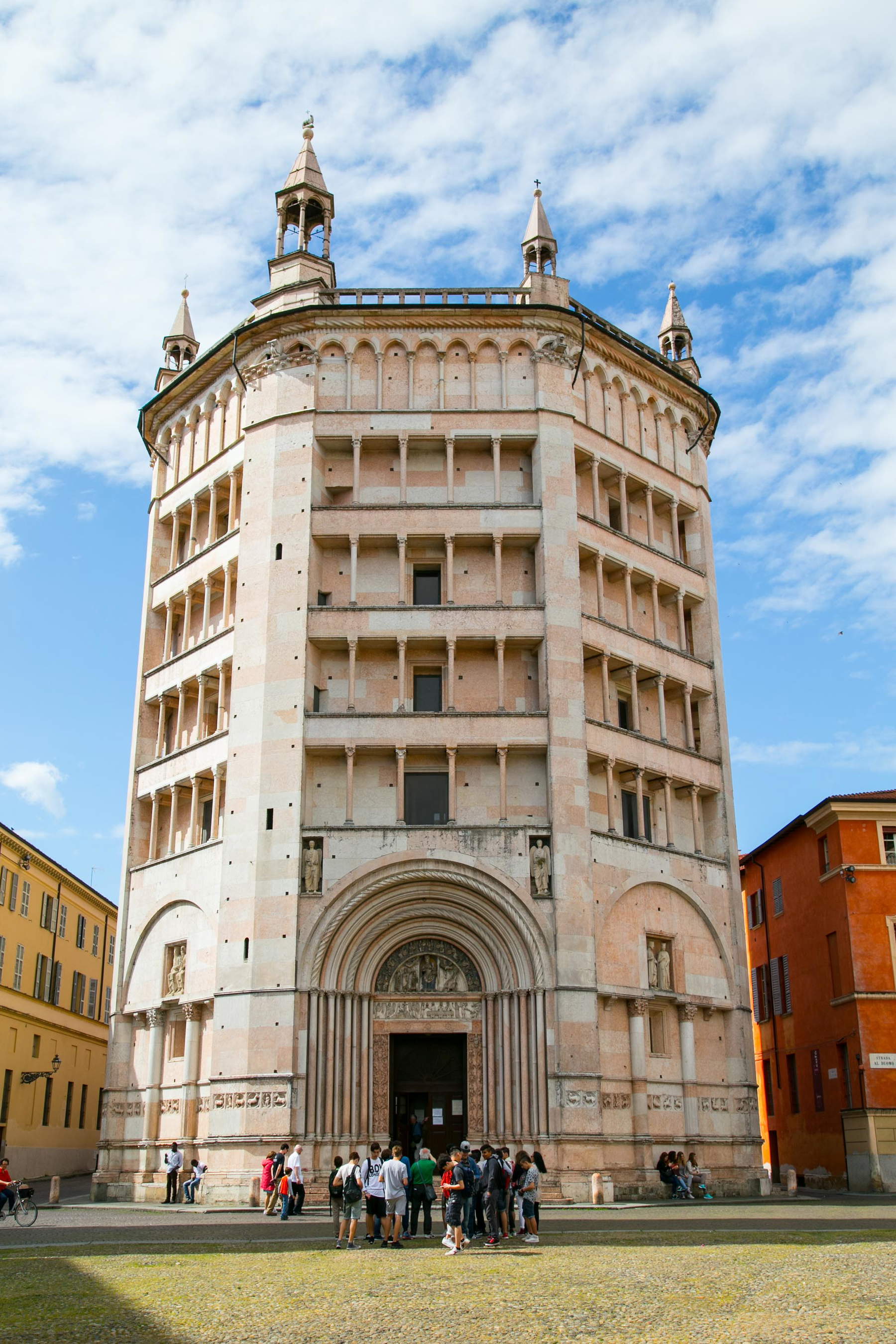 |
| The Baptistery of Parma. Ph. Credit Municipality of Parma |
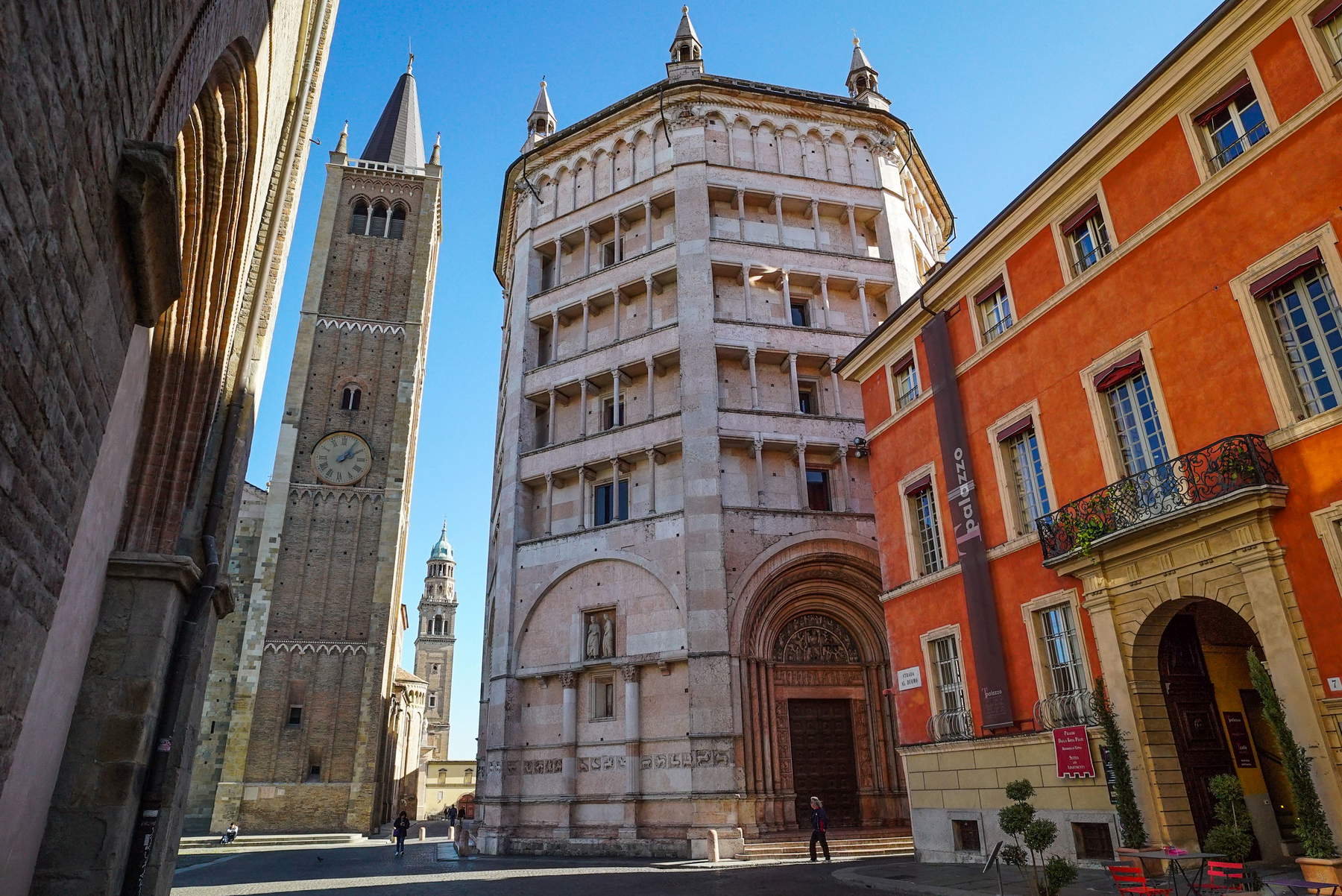 |
| The Baptistery of Parma. Ph. Credit Municipality of Parma |
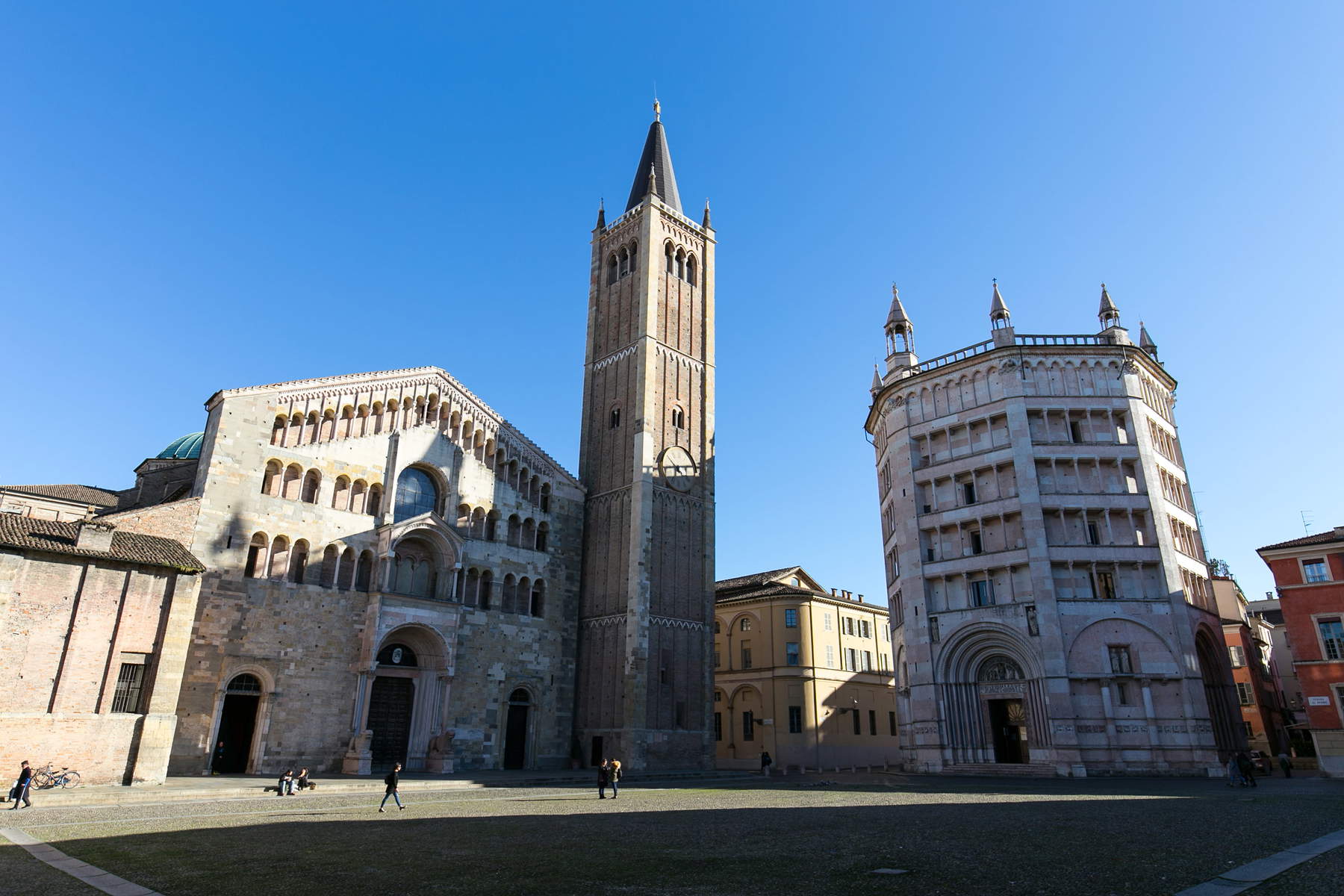 |
| Parma, Piazza del Duomo. Ph. Credit Municipality of Parma |
Starting from the northeast side of the Baptistery (i.e., the side contiguous, on the right, to the only one that is not decorated with tiles) and going all the way around the building, toward the northwest, southwest, and southeast sides, one will see in succession the seventy-five tiles listed here: the first depicts a dog or veltro, the last an eagle. These include: Half-length figures both wearing a headdress, a tunic and a cloak knotted on the shoulder and holding a staff; Donkey; Head of man with headdress depicting a lion’s head; Two rosettes; Winged dragon with twisted tail, human head, large ears and cap; Monkey; Griffin; Head of man with cap; Two winged monsters with cap and dragon’s tails: One with bearded man’s head and human feet, the other with woman’s head and goose feet; Centaur shooting an arrow; Deer eating leaves from the branches of a tree; Donkey; Dromedary; Camel; Elephant carrying a tower on its back from which the heads of two men sprout; Two Oxen; Swan or coot on the water; Griffin; Satyr shooting an arrow; Wounded lion; two Basilisks with heads of rooster and bird, body of dragon and legs of bird and lion respectively; Rooster; Goose; Goat; Ram; Rampant dog with cap; Bull or ram; Unicorn facing right; Seated female figure holding an olive branch or flower; Unicorn facing left; Dog; Hare; Panther or leopard with almost human ears and cap; Mermaid; Lioness wounded by satyr’s dart; Satyr with cap shooting an arrow; Hydra; Peacockess; Peacock; Winged quadrupeds; Cat; Dog; Centaur in female likeness and Centaur shooting an arrow; Eagle; two Horses; two Wolves or Hyenas; two Sea Dogs; Sea Cat; Ulysses; Sea Cat; Sea Horse; Hawk or other bird of prey; Sea Horse; Wounded Roe; Satyr shooting an arrow; Centaur shooting an arrow; Goat; Roe; Harpy; Lion’s Head; Capricorn; Boar; Lion’s Head.
 |
| The tiles of the northeast side (from the human figure to the camel). |
 |
| The tiles of the northwest side (from the dromedary to the unicorn) |
 |
| The tiles of the southwest side (from the hare to the horse) |
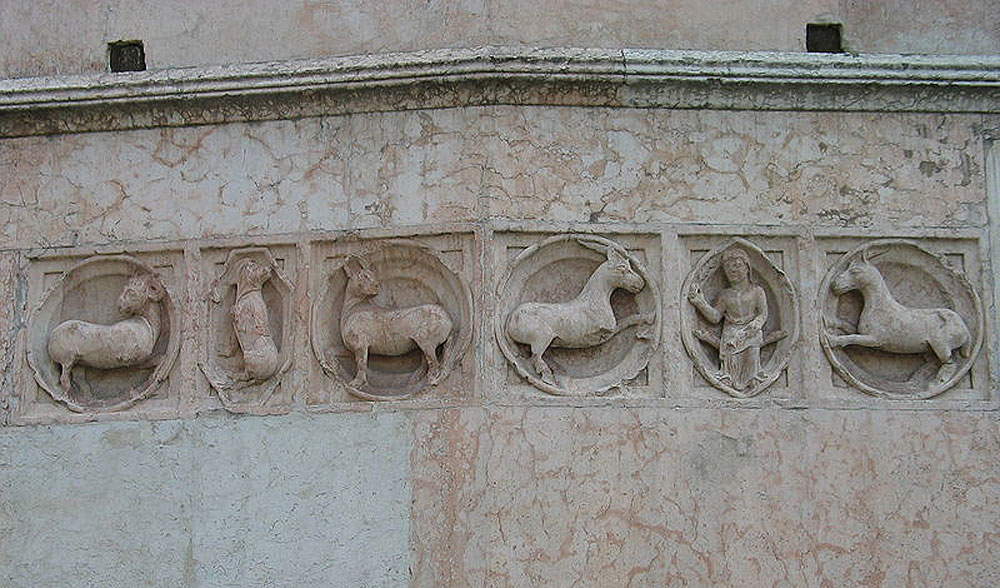 |
| Detail of the zooforo. Ph. Credit Francesco Bini |
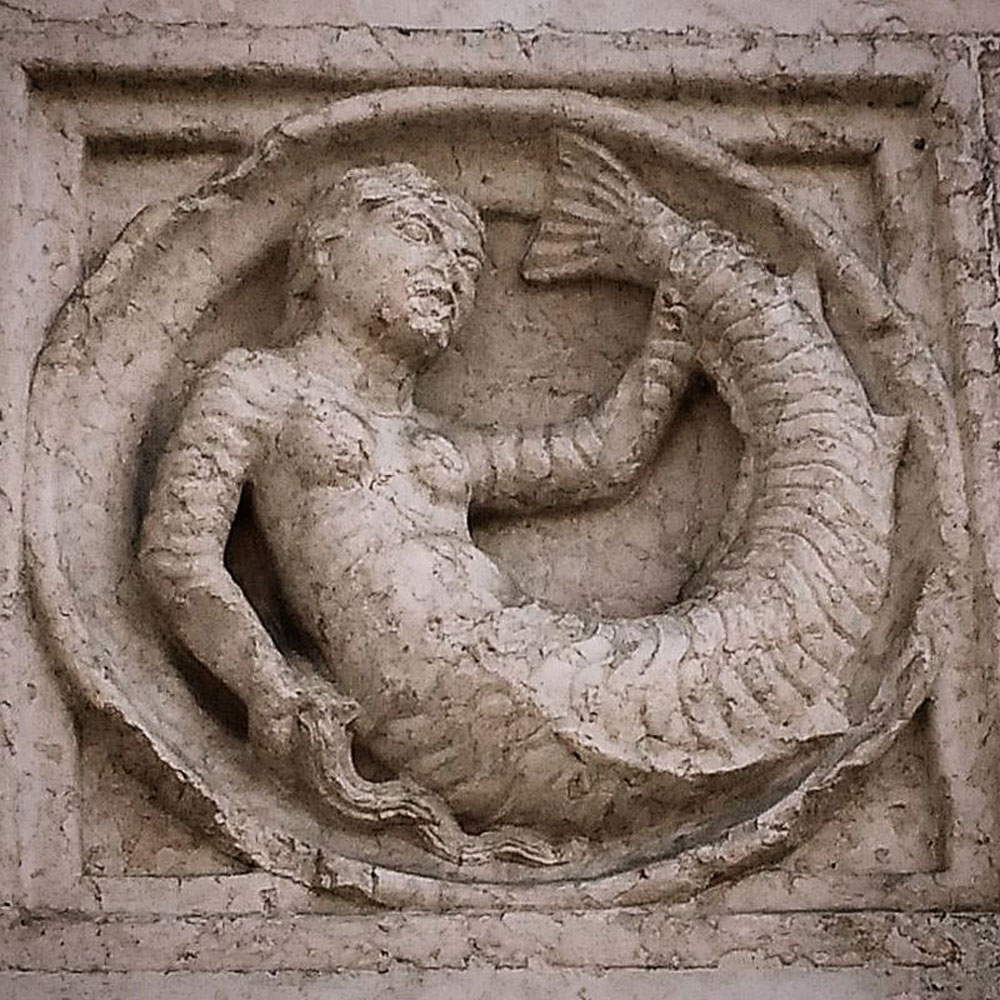 |
| The mermaid tile. Ph. Credit Francesco Bini |
Three large portals follow one another along the perimeter of the architectural structure: the northern one, which faces the Piazza del Duomo, is called the Virgin’s, the western one is called the Redeemer ’s, and the southern one is the Baptist’s portal, each with lintels and lunettes and decorated with sculptural works by Antelami himself. Seen as a whole, all three refer to the representation of human life and its redemption to attain salvation.
The Portal of the Virgin turns out to be the more elaborate and illustrated than the other two. In the front jambs is decorated with depictions of two family trees: on the right that of Mary and the figures of the ancestors are seated on branches that start from a branch generated from Jesse’s chest, while the inner part is decorated with branches of theTree of Life with birds (at the base a hawk and a rooster); on the left the family tree of Jacob ending with Moses: also visible here are branches with doves and at the base two dragons. Thearchitrave illustrates stories of St. John the Baptist with the Baptism of Jesus, Herod’s banquet, and the beheading of the saint. The lunette depicts in the center the enthroned Virgin and Child, to whose right the Angel exhorts Joseph to flee to Egypt, and to the left the Magi, each with his name. Thearchivolt shows prophets holding medallions with portraits of the apostles in their hands; the Virtues are depicted on either side of the portal, while the two large statues of Archangels Gabriel and Michael are placed in the niches. The chosen and highly detailed iconography reveals knowledge of the biblical sources and exegesis of the time, as well as a refined theological culture.
The Portal of the Redeemer is decorated on the sides with scenes of works of charity, on the left, such as a richly attired man greeting a pilgrim, the washing of feet, a man handing food and drink to two poor men, a man handing food to a prisoner, and another handing a robe to a poor man, while on the right is depicted the parable of the vineyard and the man: through the different scenes, the vine branch ascends to the last one at the top, in which the whole family is gathered around the father. On the lintel is the Day of Judgment, or rather, the moment that preludes the Final Judgment: angels blow trumpets, while from the tombs emerge the risen, on one side those who will be blessed, on the other those who will be punished. In the lunette the redeeming Christ is seated on a throne in the center and shows the signs of the Passion. The archivolt is dedicated to the apostles.
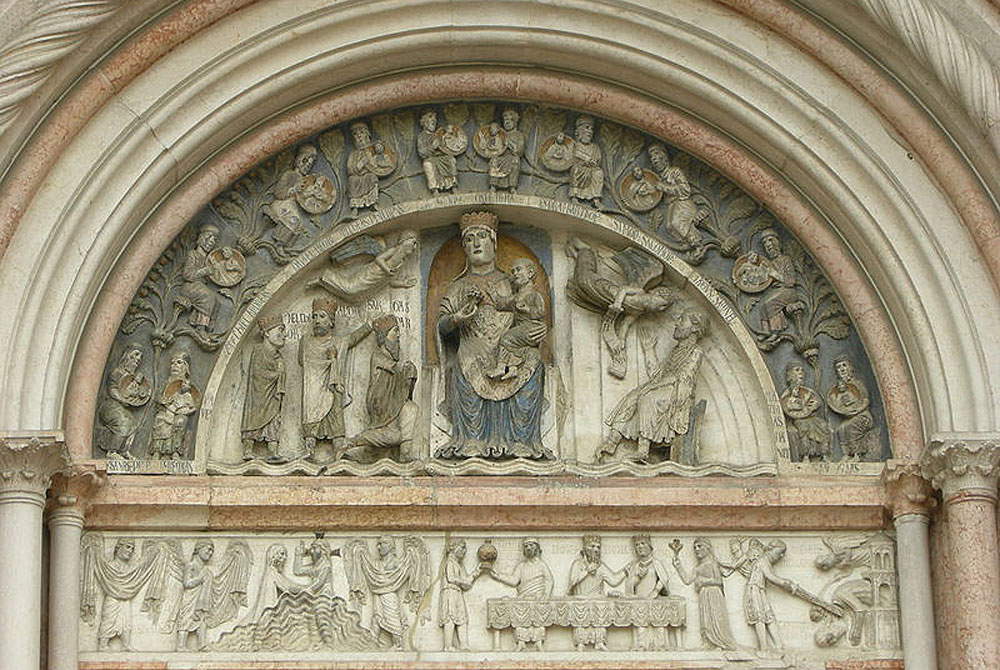 |
| The portal of the Virgin. Ph. Credit Francesco Bini |
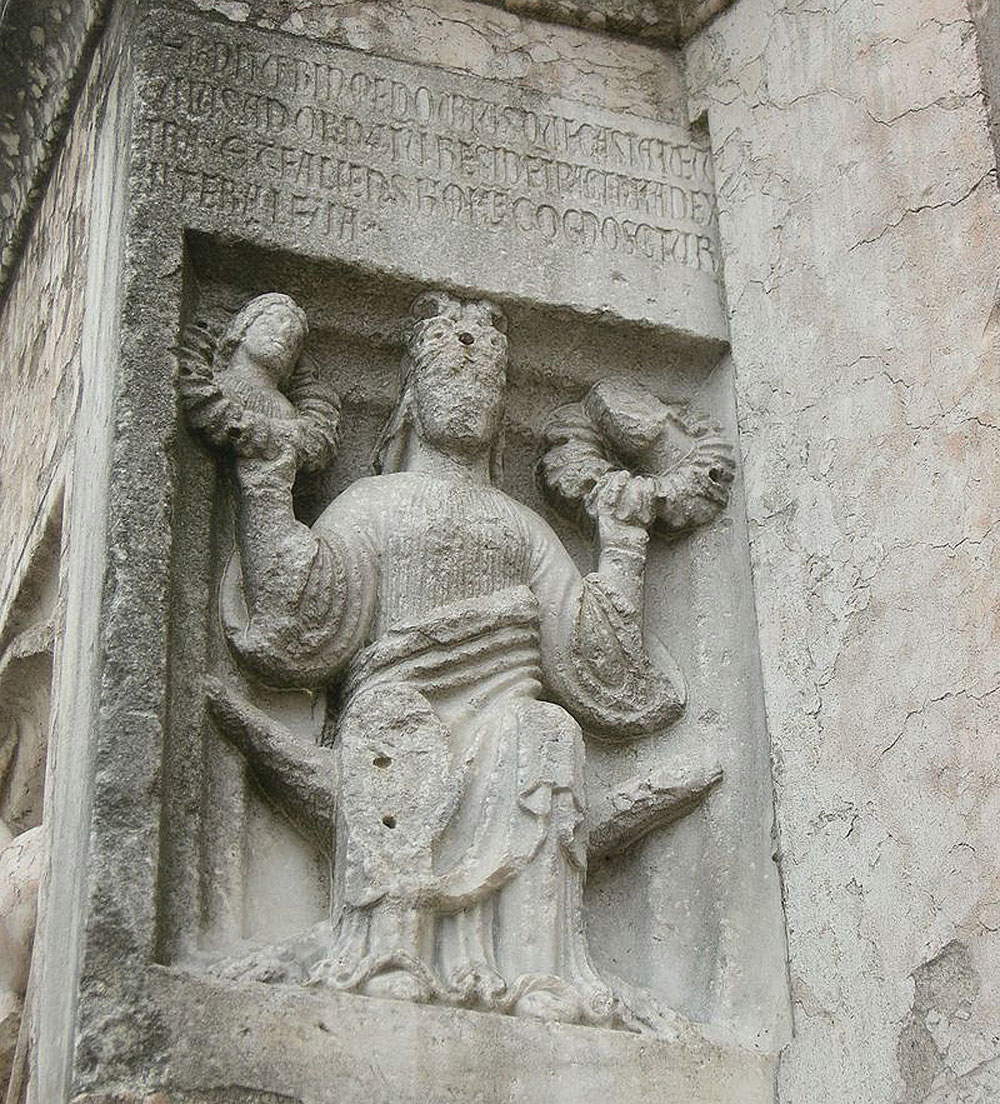 |
| One of the virtues. Ph. Credit Francesco Bini |
 |
| Detail of Mary’s family tree. Ph. Credit Francesco Bini |
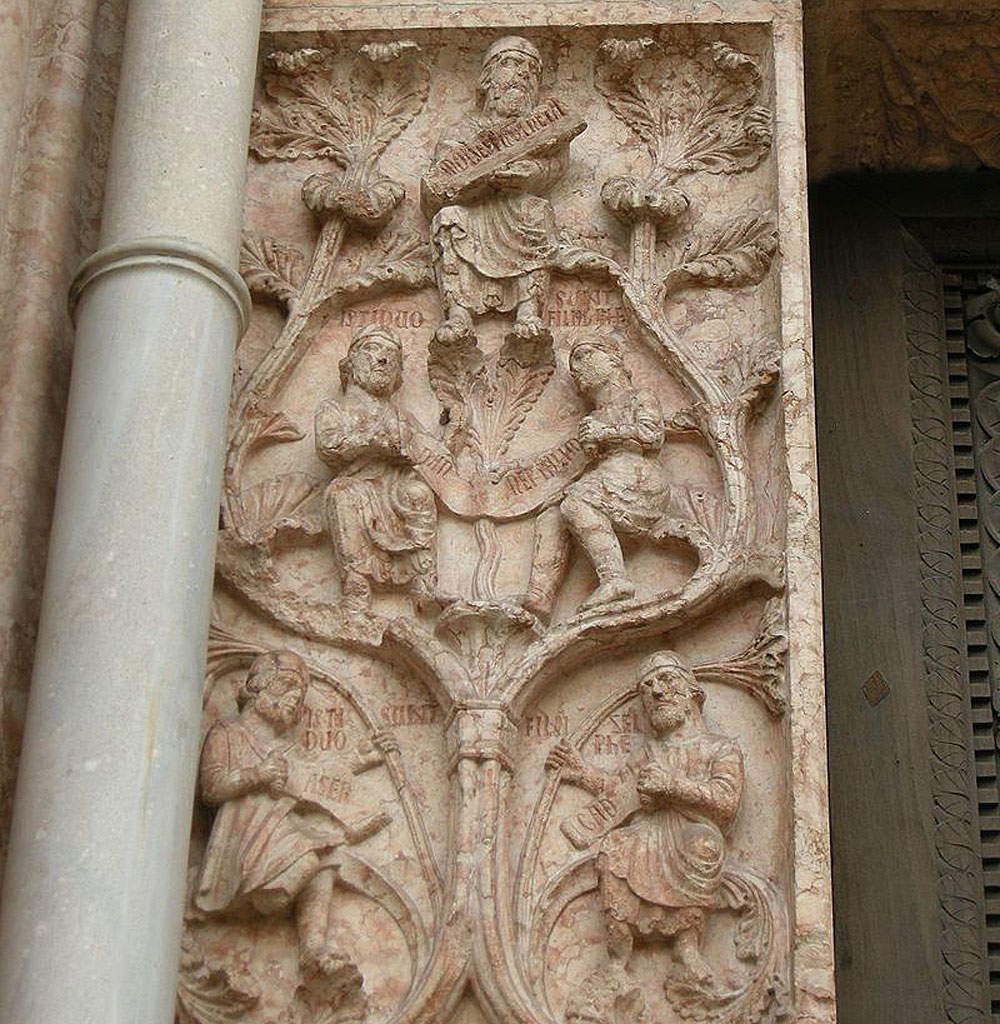 |
| Detail of Jacob’s family tree. Ph. Credit Francesco Bini |
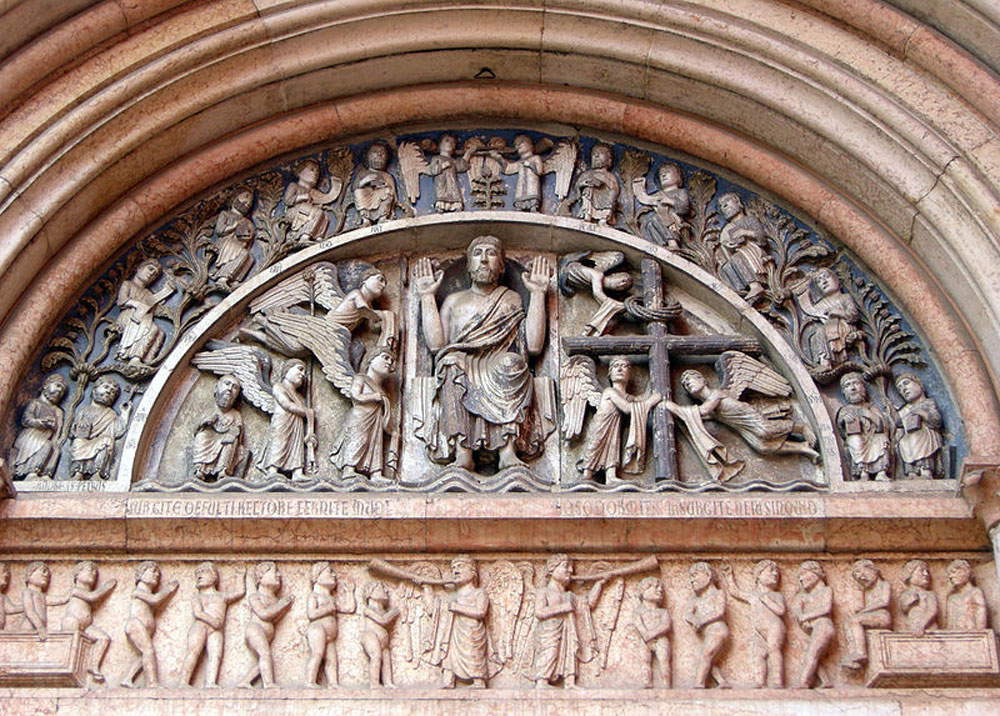 |
| The portal of the Redeemer. Ph. Credit Francesco Bini |
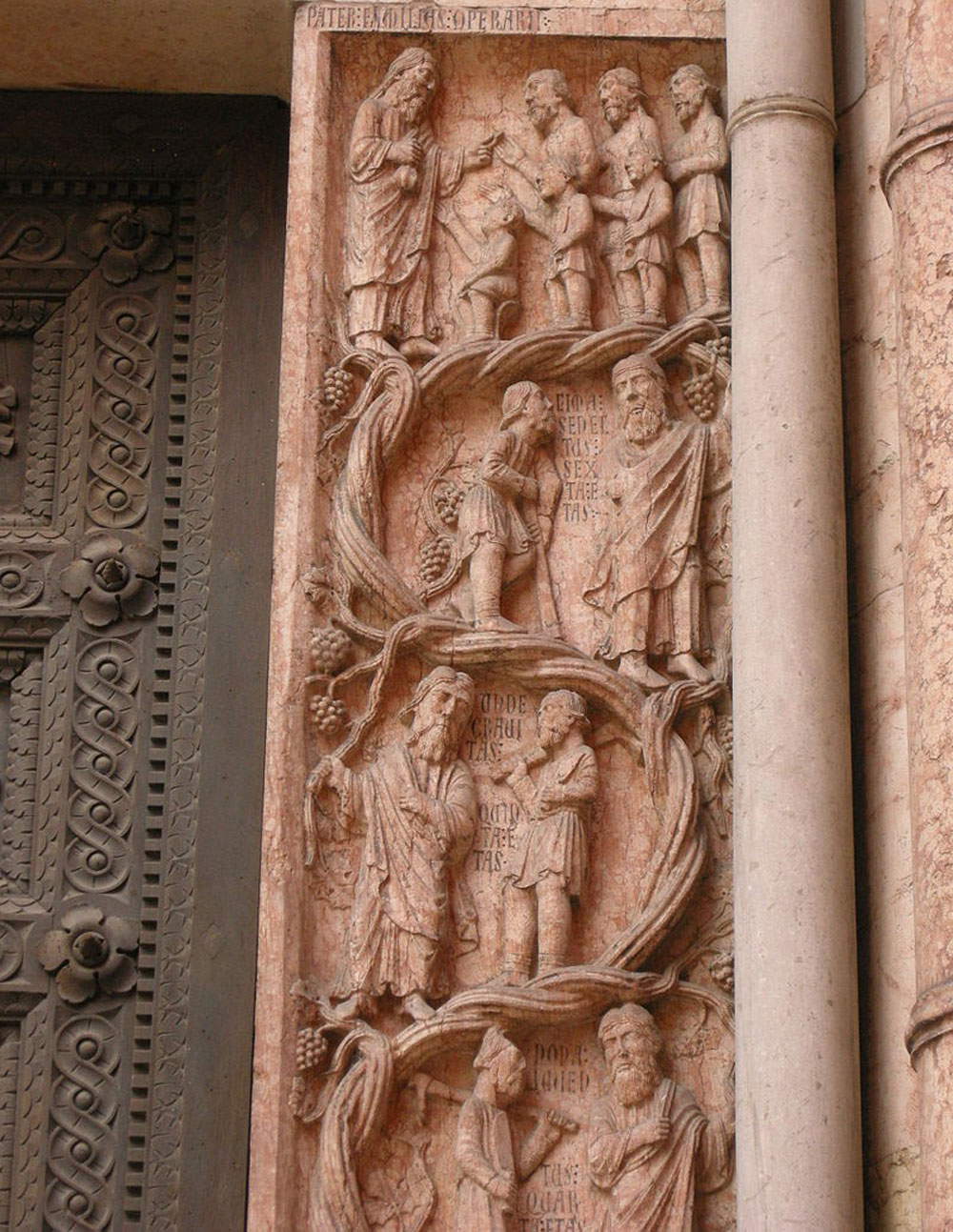 |
| Detail of the parable of the vineyard. Ph. Credit Francesco Bini |
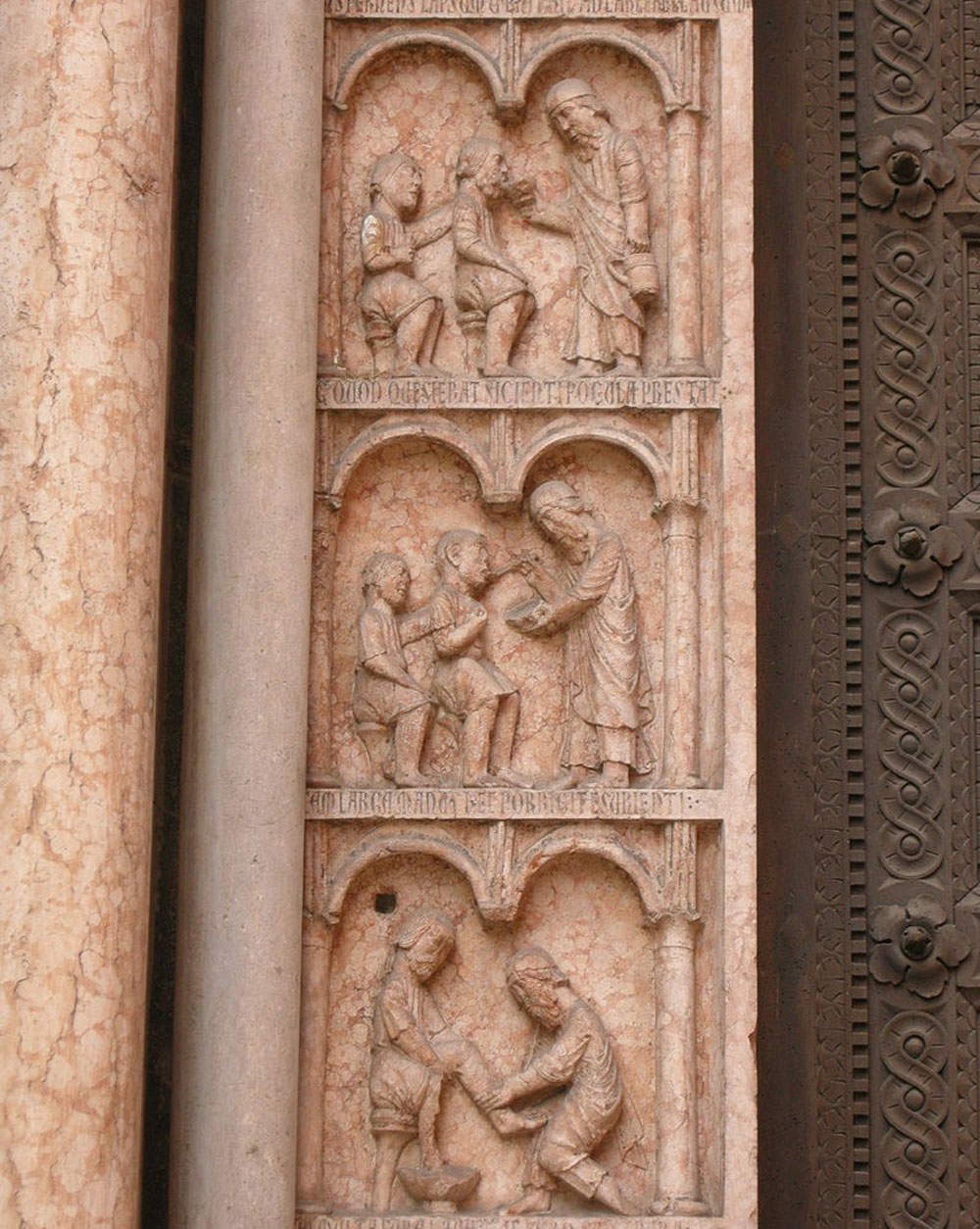 |
| Detail of the works of Charity. Ph. Credit Francesco Bini |
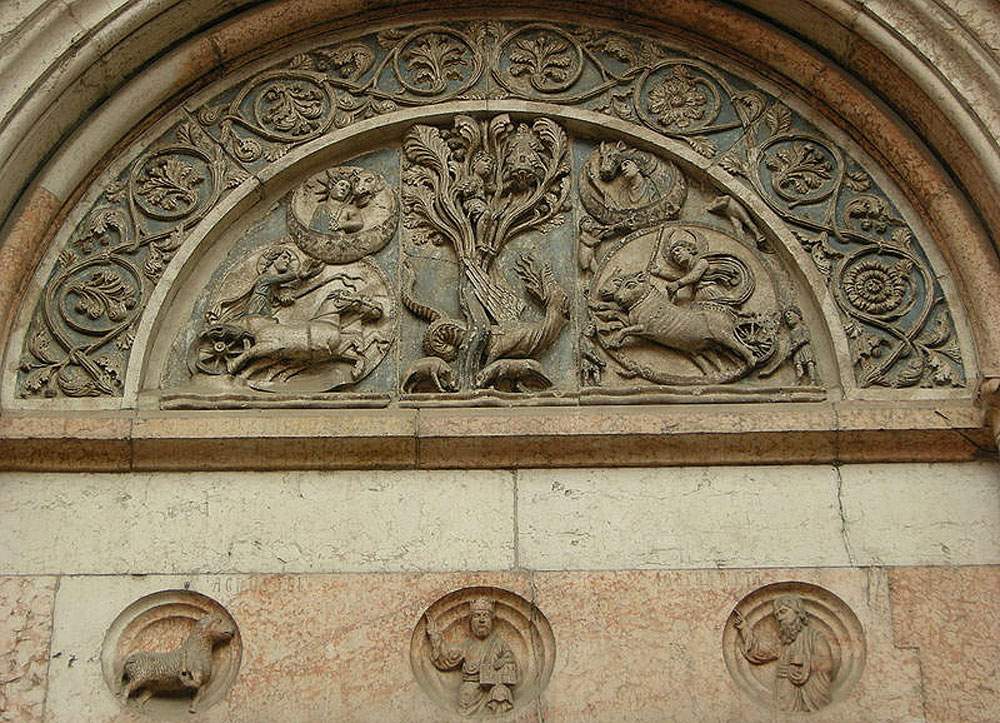 |
| The portal of the Baptist. Ph. Credit Francesco Bini |
The Baptist Portal, through which those who were to receive the sacrament of Baptism entered, is the least illustrated of the three: it is so only in the lunette with the archivolt and lintel. It describes one of the ten apologies in the Romance of Barlaam and Josaphat, among the most widespread hagiographic tales in all medieval literature and part of the exempla literature. Relative to the study of this portal we focused particularly on the depiction of the famous apologue in the lunette and of it, especially the central part. The apologue with the Legend of Barlaam is a short allegory of the universal human condition: a man being chased by a ferocious animal falls into an abyss into which he clings to a shrub (a tree symbolizing life), on a branch of which he finds a beehive with honeycomb full of honey; he is attracted by its sweetness (symbolizing the pleasures of life) and intent on tasting the honey he forgets the dangers that loom over him: two rodents (symbols of day and night in their continuous alternation) are gnawing at the roots of the tree, and a fierce dragon (symbol of Evil) is ready to devour him. An invitation then to beware of the dangers that threaten human life. It seems that in the Baptistery of Parma the iconography of that apologue was chronologically the earliest in all medieval Western art. The theme of the passage of time is underscored on either side of the tree, in a kind of dialogue with the two rodents, by depictions of the Sun and Moon driving two chariots drawn by horses and oxen. In the architrave are placed the figures of the Agnus Dei, Christ and the Baptist. On thearchivolt runs a shrub with eight whorls: unlike the other two portals, it is not populated by other figures, but the number eight refers to Christ’s resurrection, as does the octagonal shape of the Baptistery itself. The entire Baptist portal can thus be read as human existence, which, if left to itself, appears to be an insoluble enigma since it is destabilized by death, the passage of time and Evil, but which finds its ultimate solution in redemption. Also linked to this theme are other elements of the exterior of the Baptistery, namely the zooforo, which as mentioned above represents in the form of animals the moralistic behaviors that humans should follow, and the four slabs of the Virtues, pillars for a life dedicated to the Good.
The iconographic program as a whole is thus symbolic of the life of man as the object of Christ’s redeeming action as opposed to the power of Evil, the most insidious temptations, and the death that reduces everything to dust.
Warning: the translation into English of the original Italian article was created using automatic tools.
We undertake to review all articles, but we do not guarantee the total absence of inaccuracies in the translation due to the program. You can
find the original by clicking on the ITA button. If you find any mistake,please contact us.











































